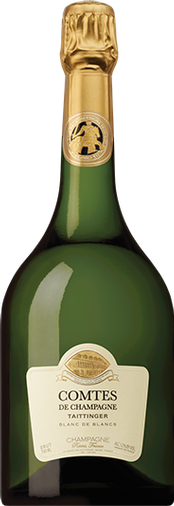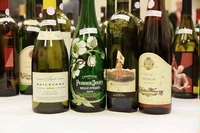|
|
 |
|
July 14, 2013
I’m grateful rather than gloating when saying this, but nevertheless: I’ll bet that however good your Friday night may have been--mine was better. I spent it tasting all of the current  Champagne releases in the USA from Taittinger, a great house that has slipped beneath my radar lately due to chronic overwork. Champagne releases in the USA from Taittinger, a great house that has slipped beneath my radar lately due to chronic overwork.
Whether my efforts ever count as “work” is a fair question, and that’s particularly true in this case, as the wines were uniformly enjoyable and also stylistically coherent, yet possessed of distinct personalities rather than seeming uniform in character. Imported by Kobrand and widely available, Taittinger’s Champagnes deserve another look if you’ve lost touch with them. That’s a mistake that I won’t make again anytime soon. Retail prices for Champagne vary quite widely, so shopping around is often worth the effort:
Taittinger Champagne Brut “La Francaise” NV ($50, Kobrand): Taittinger’s Brut La Française is one of the biggest brands from Champagne, and consequently it is prone to being overlooked in an era when boutique is chic and “grower” Champagnes have grabbed the attention of most wine writers. Be that as it may, this is still one of the most reliable choices in the entire Champagne category for those who seek freshness and refinement, and the current release lot in the USA excels on both of those counts. Still quite youthful and energetic, it will actually improve for at least two or three years if left to age, but it also shows interesting complexities from older reserve wines that were built into the multi-vintage blend. The wine’s light, lemony character makes it an exceptionally refreshing aperitif Champagne, but those who taste attentively will also find some sneaky power and nuance here, and this is a great choice for delicately prepared fish dishes. 90
Taittinger Champagne Brut Rosé “Prestige” Brut NV ($65, Kobrand): Almost everyone in the wine writing world loves to love rosé Champagnes, but I confess I’ve never gotten on that bandwagon. Rosés from Champagne often seem (to me, at least) to lack the elegance, complexity and minerality that distinguish true Champagne from the many pretenders to its throne, and I rarely find that the bigger body in rosés is worth the trade. However, Taittinger’s elegant style seems to protect this house from turning out chunky, overt wines, and indeed the pale, delicate color of this wine is a welcome sign of restraint before one even gets a nose into the glass. Light yeasty aromas are quite appealing but still subtle, allowing the lovely red fruit notes to hold center stage on the mid-palate and through the finish, which is flavorful but never  obvious. This is a great choice for those wishing to experience a truly classy rosé Champagne, but who may not quite be prepared to pony up for the other-worldly Taittinger “Comtes de Champagne” Brut Rosé. 92 obvious. This is a great choice for those wishing to experience a truly classy rosé Champagne, but who may not quite be prepared to pony up for the other-worldly Taittinger “Comtes de Champagne” Brut Rosé. 92
Taittinger Champagne Brut Grands Crus “Prélude” NV ($70, Kobrand): Taittinger’s Prélude is a rather unusual Champagne with many virtues, chief among which are outstanding integration, softness and drink-ability. Although a non-vintage wine, its pedigree is indisputably strong, with all of the juice sourced from villages in the region designated with grand cru status. The blend is split evenly between Chardonnay and Pinot Noir, which is one source of its balance, with the other key factor being a full five years of ageing prior to disgorging. Of course, those who understand how Champagne is constructed will know that blending is no argument against wine quality even in vintage-dated wines, and blending across vintages is yet another way to achieve a balanced and consistent wine. Rich and soft but still relatively light and refreshing, this shows the Taittinger style beautifully, with terrific balance between fruit, acidity and yeast. The effervescence is creamy in texture but still energetic, and one of the wine’s strengths is that it is fully ready to enjoy but also capable of developing additional complexity and weight for those who are willing to trade some freshness in search of those qualities. 93
Taittinger Champagne Brut “Les Folies de la Marquetterie” NV ($70, Kobrand): The current release of this wine in the USA is the only exposure I’ve ever had to it, so this is all about first-blush impressions, but the two of us are off to a very good start. Les Folies is a single-vineyard cuvee, presumably one that was introduced in answer to the rise of “grower Champagnes,” which have become sufficiently successful to cause some sleepless nights among managers at the Grandes Marques. Stylistically, it is a bit surprising in the context of Taittinger’s typical profile, as its chief characteristics are richness, depth and complexity, whereas I usually turn to Taittinger for lean, lemony, linear wines. But let me be clear: There’s nothing remotely oafish about les Folies, which is rather assertive for Taittinger but still a very sophisticated Champagne, even though there’s more bass and a little less treble than one associates with the house. 93
Taittinger Champagne Brut Millésimé 2005 ($70, Kobrand): I suspect that the staff at Taittinger wouldn’t appreciate this, but it seems apparent to me that their Millésimé Brut has fallen into relative obscurity after they introduced the non-vintage but Grand Cru “Prélude” bottling (which is a real attention-grabber at an equivalent price in the middle ground between the NV Brut “La Francaise” and the top-shelf “Comtes de Champagne” wines). Now that Taittinger has also brought out “Les Folies de la Marquetterie” Brut NV at this same price point, one wonders how the Millésimé will fare in terms of profile. Perhaps it will rebound, and perhaps this 2005 will be the turn-around release. By comparison to “Prélude,” it is considerably more energetic and age-worthy, though not as creamy, complex, or optimally  aged for current consumption. A core of bright red berry fruit is very fresh but also impressively deep in flavor, with restrained yeast notes. The effervescence is very fine in texture but abundant in volume, and the acidity is ripe but still quite prominent and fresh. If forced to choose at gunpoint, I’d buy the “Prélude” to drink tonight, but of the two, this Millésimé is the one I’d choose for my cellar. 93 aged for current consumption. A core of bright red berry fruit is very fresh but also impressively deep in flavor, with restrained yeast notes. The effervescence is very fine in texture but abundant in volume, and the acidity is ripe but still quite prominent and fresh. If forced to choose at gunpoint, I’d buy the “Prélude” to drink tonight, but of the two, this Millésimé is the one I’d choose for my cellar. 93
Taittinger Champagne Brut “Comtes de Champagne” Blanc de Blancs 2004 ($195, Kobrand): Taittinger’s Blanc de Blancs bottling at the flagship “Comtes de Champagne” level is always less expensive than the Rosé, but often a wine that is even more complex and complete. The current 2005 Rosé release is so good--and so much better than most other cuvée de prestige Rosé Champagnes--that I can’t quite give this 2004 Blanc de Blancs an edge over it, but there’s no doubt that this wine will stop you in your tracks. It isn’t as rich or weighty as some earlier vintages, but clearly makes up for that with amazing linear energy, as the focused citrus flavors are remarkably persistent, culminating in a finish that seems to go on for a full minute after the wine has cleared the palate. The flavors are strikingly fresh, as the yeast signature is quite subtle, and indeed the wine seems much more mineral than yeasty in character. Now nearly nine years old, this is only starting to hit its stride, and it will surely benefit from cellaring for a full decade and perhaps longer. 96
Taittinger Champagne Brut “Comtes de Champagne” Rosé 2005 ($220, Kobrand): The 2005 Comtes Rosé is frighteningly good, and you would be well advised to place most of your financial resources in escrow before trying this wine--for fear that you’ll empty your accounts to buy more of it. One of the Champagne region’s most intricate and stylish rosé wines, this is always outstanding, but the 2005 seems particularly energetic and engaging, with vibrant red berry fruit and interesting accents of bread crust, anise seed and marzipan. One of its best qualities is that it is very expressive and full of flavor but really only medium-bodied, so it will be a great treat at the table if you can manage to keep from drinking all of it before dinner. A thoroughly compelling wine. 96
Posted by Michael Franz at 2:53 PM
|
|
July 4, 2013
Wine blogger Joe Roberts, the infamous 1WineDude, offers an interesting perspective on wine competitions after participating in several of the major competitions this year.
 In a post intended to debunk a number of myths about wine competitions, and to spoil the fun for those who would discredit the results as unreliable, Joe arrives at the conclusion that wine competitions certainly aren't perfect, but trusting the evaluations of wine pros who sample thousands of wines every year sure beats the alternative. In a post intended to debunk a number of myths about wine competitions, and to spoil the fun for those who would discredit the results as unreliable, Joe arrives at the conclusion that wine competitions certainly aren't perfect, but trusting the evaluations of wine pros who sample thousands of wines every year sure beats the alternative.
The alternative being a visit to the grocery story for a trip down the wine aisle without a clue. That's what most people do and it's a hit-or-miss proposition, at best. That and the fact that there's real money on the line is what drives many consumers to consult wine ratings and/or purchase medal-winning wines.
I have a vested interest in this ongoing debate because I operate four international wine competitions and participate in several others as a judge.
 I have tremendous faith in the results, and I know for a fact that a professional wine judge is capable of delivering consistent analysis. I know this because I am tested for consistency at the Concours Mondial de Bruxelles each time I'm invited to judge, and to date my scores have been consistent when tasted on the same wine twice, always blind. I have tremendous faith in the results, and I know for a fact that a professional wine judge is capable of delivering consistent analysis. I know this because I am tested for consistency at the Concours Mondial de Bruxelles each time I'm invited to judge, and to date my scores have been consistent when tasted on the same wine twice, always blind.
I also have faith in the results because I make it my business to invite only competent, proven wine pros to judge at the competitions I stage. The recent Critics Challenge is but one example. Those guys are good.
And for the upcoming Sommelier Challenge in September I believe I have the strongest group of Somms in the five years of that competition.
Wine is a living thing and sometimes even good wines don't show well on judgment day. But if James Tidewell, MS (Sommelier Challenge) or Leslie Sbrocco (Critics Challenge) tells me a wine is deserving of a gold medal, I would be inclined to give it a try.
Wine judging isn't rocket science. Most of us who taste wine for a living know when we have a good one in the glass. You would have to be a fool, as iWineDude says, to think otherwise.
Posted by Robert Whitley at 12:32 PM
|
|
July 2, 2013
For most of my professional career, the sommelier has been a relic of the past, a symbol of that forgotten time when only the wealthy ordered fine wine off a restaurant wine list and only the stuffiest, most image-conscious restaurants found it necessary to employ a certified wine professional to cater to their upper-crust clientele. A restaurant with a sommelier was considered by most casual wine drinkers to be wine snobbery on steroids.
The world has changed, and so has the professional sommelier. To some extent much of the credit for the change goes to the Court of Master Sommeliers, which trains, tests and certifies sommeliers in four distinct levels of expertise and maintains the professional standards that have shaped the world of the modern sommelier.
 "Somm," the movie, is a documentary by Jason Wise that follows four young sommeliers as they prepare for the Master Sommelier (MS) exam. "Somm" is now showing in theaters around the country and also is available at the iTunes store. "Somm," the movie, is a documentary by Jason Wise that follows four young sommeliers as they prepare for the Master Sommelier (MS) exam. "Somm" is now showing in theaters around the country and also is available at the iTunes store.
If you have the vaguest interest in wine and dine out with any frequency, you need to see this film. Whatever you think you know, or could possibly imagine, about the world of the professional sommelier, do yourself a favor and check your assumptions at the door. The subjects of the documentary — Ian, Justin, Brian and JLynn — are ordinary guys with one exception: All four have a passion for wine that has morphed into obsession, which in turn has inspired their quest to be the best they can be at their chosen profession.
Of the four levels of expertise certified by the Court of Master Sommeliers — Level 1, Certified, Advanced and Master — the Master level is the highest and most difficult to achieve. Of those who take the Master Somm exam, only 3 percent pass. There are but 200 or so master sommeliers in the world.
The preparation is demanding, time consuming, and mentally and physically grueling. Most sommeliers studying for the Master exam do so in teams, constantly challenging each other to improve their knowledge of the subject, their tasting skills and their service skills under extreme pressure. Many brilliant sommeliers never pass the Master exam despite multiple attempts. It's that hard.
Wise in his documentary follows one such study group. The film was three years in the making and made a huge splash at the Napa Valley Film Festival earlier this year. The four characters are compelling at a very basic human level, while resisting the urge to give in to a fear of failure as they immerse themselves in what to many might seem to be an impossible dream. Master Sommelier Fred Dame, a legendary sommelier and one of the testers at the Master exam, is brilliant simply being himself.
The film is polished and sophisticated in the way "Sideways" never was, and the characters had the crowd at my screening cheering and sighing as the results of the exam were announced. "Somm" is entertaining, at times great fun, and, I daresay, delivers an important message about the growing presence of the modern professional sommelier in the restaurant industry.
Posted by Robert Whitley at 11:22 AM
|
|
 |
|